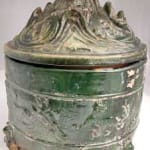Han Green-Glazed Lien, 206 BCE - 220 CE
Glazed Terracotta
11.75
H.827
Further images
Lidded food containers of this type are known as . This lively green-glazed is notable for its elegant decorations. The fabulously molded lid takes on the form of the Sacred...
Lidded food containers of this type are known as . This lively green-glazed is notable for its elegant decorations. The fabulously molded lid takes on the form of the Sacred Mountain, featuring various animals and mythological creatures climbing towards its jagged peak. The container stands raised on three charming feet molded in the shapes of bears carrying the vessel on their backs. The side of the body is embellished with a panel in low relief depicting a mythological hunting scene. Here, the combination of swirling terrain, undulating tree, and rampant beasts recall the motifs of the lid. The gorgeous green glaze recalls similar works in bronze, and the glaze has acquired a beautiful, soft iridescent patina over the ages. Commonly referred to as “silver frost,” this iridescence is the result of wet and dry periods in a tomb whereby the clay dissolves the lead glaze and redeposits it on the surface, where it hardens. A testament of age, this patina is also admired by collectors for its charming aesthetic qualities, similar in effect to mother of pearl. Although this vessel would have functioned as a food storage container in life, it was found discovered buried in a tomb. Such a work might have originally been buried containing food inside, to be consumed by the deceased in the afterlife. A symbol for the bountiful pleasures of life, for eating and feasting, this would have represented the joys to be experienced in the afterlife and the feasts and celebrations yet to come. Today, this vessel is not only a gorgeous work of art, treasured for its history and rarity; but also a stunning reminder of the richness and luxury of the Han Dynasty, both in this world and the next.





